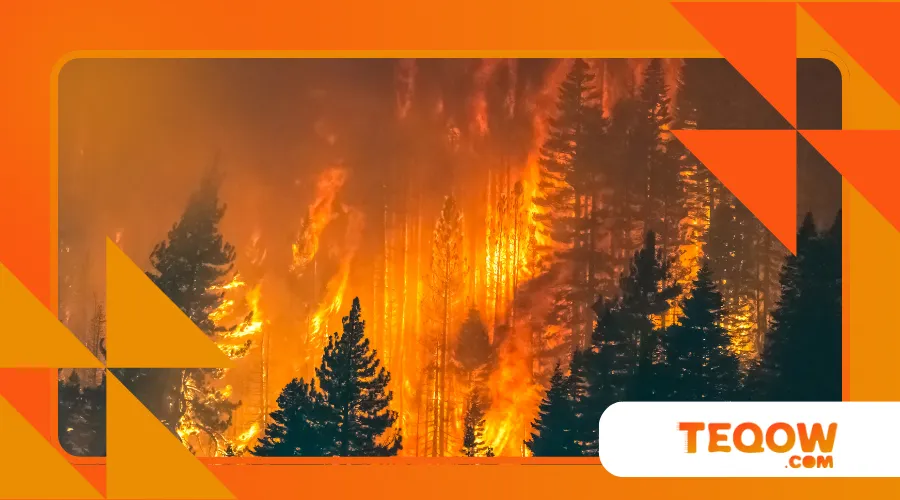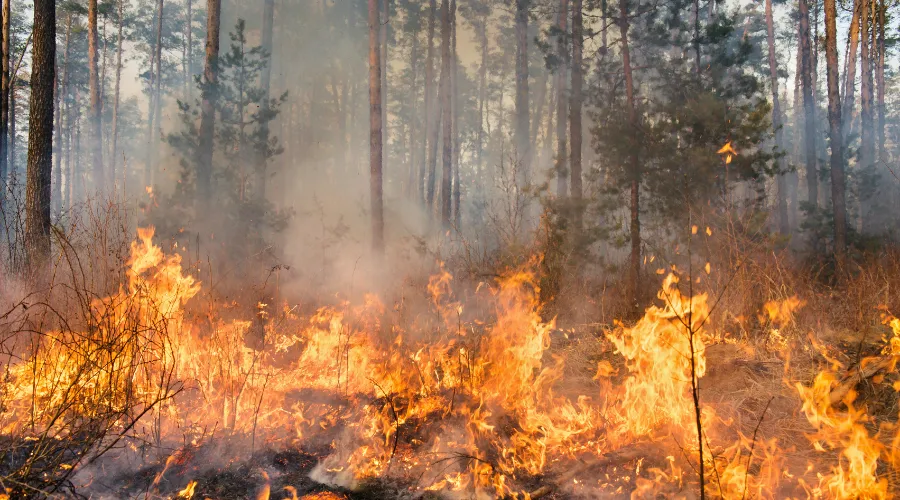Canadian Wildfire Season Off to an Early Start, Prompting Air Quality Alerts in Western Provinces

The Canadian wildfire season has roared to life earlier than expected in 2025, casting a smoky shadow over British Columbia and Alberta.
As of April 30, officials have issued air quality advisories in response to small but persistent fires near Kamloops and northern Alberta.
These early blazes, fueled by an unseasonably dry spring, signal a potentially grueling summer for firefighters and residents alike.
With respiratory health warnings already in place, the question looms: are we prepared for what could be another record-breaking fire season?
As climate change continues to alter weather patterns, the frequency and intensity of wildfires are expected to increase, making preparedness more crucial than ever.
A Premature Spark in a Parched Landscape
Spring in Western Canada typically brings renewal—lush greenery and melting snowpacks.
Yet, 2025 has defied this rhythm.
Drought conditions, lingering from a dry winter, have left forests and grasslands tinder-dry.
In Kamloops, a small fire ignited in early April, charring 50 hectares before crews contained it.
Similarly, northern Alberta’s boreal forests saw flames flare near Fort McMurray, a region still scarred by the 2016 megafire.
These incidents, though controlled, underscore a troubling trend: the Canadian wildfire season is no longer confined to summer months.
The implications of this shift are profound, affecting not only ecosystems but also local economies that rely on tourism and outdoor activities.
Data from the Canadian Interagency Forest Fire Centre (CIFFC) reveals a stark reality.
In 2024, British Columbia alone reported 1,687 wildfires, burning over 1.07 million hectares—well above the 10-year average.
Alberta followed with 1,224 fires, scorching vast swaths of land.
The early fires of 2025 suggest this pattern may persist, driven by climate shifts and persistent drought.
Such trends highlight the urgent need for comprehensive wildfire management strategies.
The Air We Breathe: Health Risks on the Rise
Smoke from these early fires has already degraded air quality, prompting advisories across Western Canada.
In Kamloops, particulate matter (PM2.5) levels spiked to “unhealthy” ranges, posing risks to those with asthma or heart conditions.
Northern Alberta’s Fort McMurray reported similar conditions, with residents urged to limit outdoor activity.
These alerts are not mere inconveniences—they’re a clarion call to address the health impacts of a lengthening Canadian wildfire season.
Consider Sarah, a fictional Kamloops schoolteacher with chronic bronchitis.
On April 25, she woke to a haze blanketing her neighborhood, her chest tightening with each breath.
Schools canceled outdoor recess, and Sarah relied on her inhaler more than usual.
Her story mirrors thousands of real Canadians facing respiratory challenges as smoke infiltrates communities.
The Canadian Lung Association estimates that wildfire smoke exacerbates symptoms for 1 in 5 Canadians with lung conditions, a statistic that grows more alarming with each early fire.
This situation underscores the need for community health initiatives and better public awareness regarding air quality.
Why should clean air feel like a luxury?
This rhetorical question drives home the urgency of proactive measures—better air filtration in schools, real-time smoke forecasting, and community education on masking during poor air quality days.
Without these, vulnerable populations bear the brunt of nature’s wrath.
For more information on air quality and health impacts, you can visit the Government of Canada’s air quality website.
Zombie Fires: A Lingering Threat
The Canadian wildfire season’s early start isn’t just about new ignitions—it’s also about fires that never truly die.
Known as “zombie fires,” these smoldering blazes burrow into peat and organic soils, surviving winter’s chill only to reignite in spring.
In northeastern British Columbia, approximately 80 overwintering fires from 2023 remained active into 2024, some potentially burning into 2025.
These subterranean dragons, as one might liken them, exhale smoke even in subzero temperatures, complicating firefighting efforts.
Imagine a farmer near Fort Nelson, let’s call him James, noticing wisps of smoke rising from his snow-covered fields in February.
Satellite imagery confirmed his fears: a zombie fire, undetected for months, was smoldering beneath the surface.
Such fires, often invisible until they flare, challenge traditional suppression tactics and demand innovative solutions like infrared drone surveillance.
Understanding the behavior of these fires is crucial for developing effective firefighting strategies.

Climate’s Role: A Fire-Fueling Engine
Climate change is the unseen accelerant in this fiery equation.
Warmer springs, reduced snowpacks, and prolonged droughts create a perfect storm for wildfires.
The 2024 season, influenced by a fading El Niño and a weak La Niña, saw temperatures soar to 35°C in parts of Alberta, drying vegetation to a crisp.
Seasonal forecasts for 2025 predict above-normal temperatures across Canada, with northern Alberta facing particularly arid conditions.
Without significant spring rainfall, the Canadian wildfire season could rival the devastating 2023 season, which burned 18.4 million hectares nationwide.
This isn’t just weather—it’s a systemic shift.
Forests once tempered by consistent moisture now resemble kindling.
The interplay of heat, wind, and low humidity transforms sparks into infernos, as seen in the rapid spread of the 2024 Jasper fire, which destroyed a third of the town’s structures.
Addressing this requires more than firefighting; it demands policy shifts—reforestation with fire-resistant species, stricter land-use regulations, and carbon reduction to slow warming.
The interconnectedness of climate and wildfire behavior necessitates a holistic approach to environmental policy.
+ Ontario’s Electric Vehicle Supply Chain Gets a Boost
Firefighting on the Frontlines: Resilience Under Pressure
Firefighters are the unsung heroes battling the Canadian wildfire season’s early onslaught.
In British Columbia, the BC Wildfire Service deployed 1,600 seasonal personnel in 2024, with crews already mobilizing in 2025.
Alberta’s teams, bolstered by 100 Canadian Forces soldiers last May, face similar pressures.
Yet, resources are stretched thin.
International aid, including firefighters from Australia and South Africa, proved vital in 2024, and similar support may be needed this year.
Training programs are evolving to meet these challenges.
Thompson Rivers University in Kamloops will launch North America’s first civilian wildfire management program in September 2025, training 20 students in fire science and Indigenous fire practices.
This initiative signals a shift toward community-driven resilience, blending modern technology with traditional knowledge to outsmart fires.
The role of education and training in firefighting cannot be overstated; it is essential for adapting to changing conditions.

Technology as a Game-Changer
Innovation is rewriting the firefighting playbook.
In 2025, SenseNet’s AI-powered detection system, partnered with Rogers’ 5G network, will roll out in 10 Western Canadian towns, including Jasper and Grande Prairie.
Gas sensors and smoke cameras provide real-time alerts, allowing crews to tackle fires before they spiral.
Meanwhile, NASA’s Fire Events Data Suite (FEDS) tracks fire progression using satellite data, offering a near-real-time view of blaze behavior.
These tools could mean the difference between containment and catastrophe in the Canadian wildfire season.
Yet, technology isn’t a panacea.
Smoke forecasting models, like BlueSky Canada, struggle with cloud cover and external smoke sources, limiting their precision.
Investment in hybrid systems—combining AI, satellites, and ground sensors—could bridge these gaps, ensuring communities receive timely warnings.
The integration of advanced technology into firefighting strategies is crucial for enhancing response times and effectiveness.
++ Liberal Leader Mark Carney Faces Questions Over Trump’s “51st State” Comments
Community Preparedness: The Human Element
Residents aren’t passive bystanders in the Canadian wildfire season—they’re active defenders.
Programs like FireSmart Canada empower communities to create defensible spaces by clearing debris and planting fire-resistant vegetation.
In Fort McMurray, neighborhoods adopted FireSmart principles post-2016, slowing fire spread in 2024.
Scaling these efforts nationwide could reduce property losses and ease the burden on firefighters.
Education is equally critical.
Schools in high-risk areas like Kamloops are integrating wildfire preparedness into curricula, teaching students evacuation protocols and the science of fire behavior.
These initiatives foster a culture of readiness, ensuring future generations are equipped to face a fiery reality.
Community engagement and education are vital components in building resilience against wildfires.
A Call for Collective Action
The early start to the Canadian wildfire season is a wake-up call, not just for Western Canada but for the nation.
It demands a multifaceted response—robust firefighting, cutting-edge technology, community resilience, and aggressive climate action.
Ignoring these fires is like ignoring a smoldering ember in a dry forest; it’s only a matter of time before it engulfs us.
Policymakers must prioritize long-term strategies: funding for FireSmart, tax incentives for fire-resistant home upgrades, and stricter emissions targets.
Individuals, too, have a role—reducing water waste, supporting local fire crews, and advocating for green policies.
The Canadian wildfire season isn’t just a natural phenomenon; it’s a test of our adaptability and resolve.
As smoke lingers over Kamloops and Fort McMurray, the path forward is clear.
We can’t control the winds or the rains, but we can shape our response.
Will we rise to meet this challenge, or let the flames dictate our future?
The answer lies in our collective will to act—before the next spark ignites.
The time for action is now; the future of our communities depends on it.
